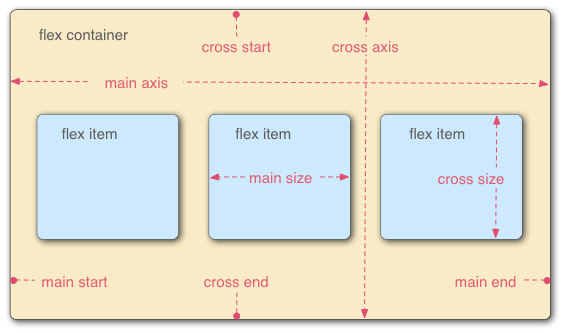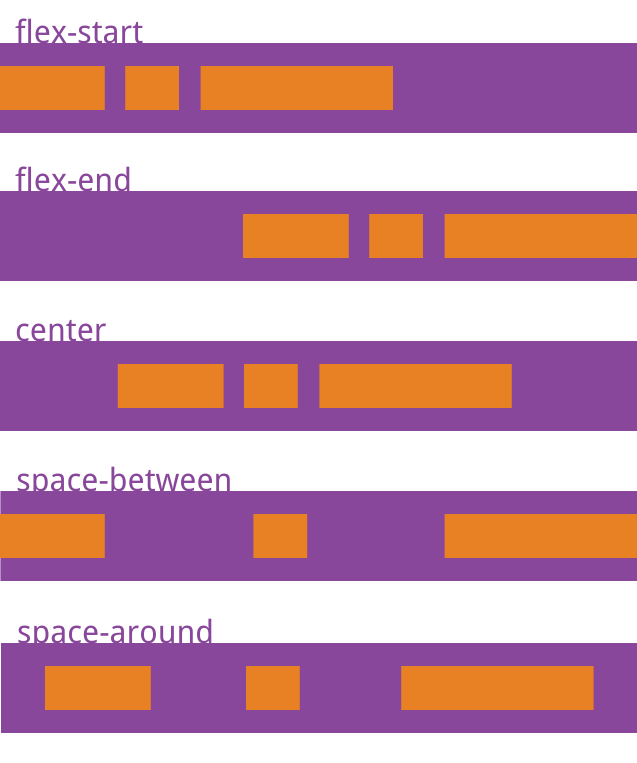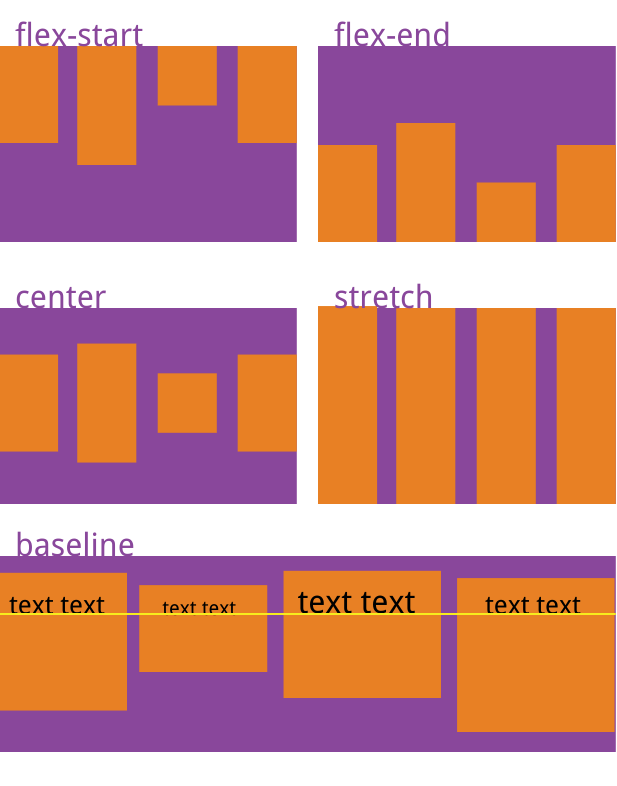序:
布局想必大家都知道,在iOS 中我们使用代码计算屏幕宽高布局,使用Autoresizing和AutoLayout进行布局。在web中的布局一般都是依靠CSS的盒子模型,09年W3C提出了一种新的布局方案,Flex布局。ReactNative就是选用了这种布局方式。下面我们来看下FlexBox布局吧。
Flex 是Flexible Box的缩写,字面上的意思就是弹性盒子。意为“弹性布局”,用来为盒状模型提供最大的灵活性。
- flexible(形容词):能够伸缩或者很容易变化,以适应外界条件的变化
- box(名词):通用的矩形容器
跟iOS AutoLayout比,我认为FlexBox的主要特点就是容器的子集可以根据容器的大小按比分配,还有丰富的对齐方式。
采用 Flex 布局的元素,称为 Flex 容器(flex container),简称"容器"。它的所有子元素自动成为容器成员,称为 Flex 项目(flex item),简称"项目"。

容器默认存在两根轴:水平的主轴(main axis)和垂直的交叉轴(cross axis)。主轴的开始位置(与边框的交叉点)叫做main start,结束位置叫做main
end;交叉轴的开始位置叫做cross start,结束位置叫做cross
end。
项目默认沿主轴排列。单个项目占据的主轴空间叫做main size,占据的交叉轴空间叫做cross
size。
-
flexDirection
- flexWrap
- justifyContent
- alignItems
3.1 flexDirection属性
flexDirection属性决定主轴的方向(即项目的排列方向)。
主要四个属性值:
- row 主轴方向为横向,从左到
- row-reverse 横向,反方向
- column 竖向,自上向下
- column-reverse 竖向,自下向上
import React, { Component } from 'react';
import {
AppRegistry,
Image,
ListView,
StyleSheet,
Text,
View,
} from 'react-native';
class RNHybrid extends Component {
render() {
return(
<View> //切换flexDirection属性看结果
<View style={{backgroundColor:'red',width:100,height:40,marginTop:100}}>
</View>
<View style={{backgroundColor:'yellow',width:100,height:40,marginTop:100}}>
</View>
<View style={{backgroundColor:'blue',width:100,height:40,marginTop:100}}>
</View>
</View>
);
}
}
AppRegistry.registerComponent('RNHybrid', () => RNHybrid);1.默认是column效果如下:
2. column 最外层View的属性加上style={{flexDirection:'column-reverse'}} 翻转了效果如下:
下面属性的就不贴了,自己试试就知道了。
3.2 flexWrap属性
如果我们的主轴为横向正向,那么我们的子控件排不开了怎么办?会自动换行吗?
代码是把上面的View宽度都变成三个加一块能超过屏幕的宽度,我的模拟器是6s,我让三个子View宽度为150。
观察demo看下答案:
默认flexWrap属性是不换行,下面来学习下这个属性。
flexWrap: nowrap
| wrap | wrap-reverse
wrap换行效果:
3.3 justifyContent属性
justifyContent属性定义了项目在主轴上的对齐方式。(自己试验是在横轴上)
justifyContent: flex-start | flex-end | center | space-between | space-around;

它可能取5个值,具体对齐方式与轴的方向有关。下面假设主轴为从左到右。
flex-start(默认值):左对齐flex-end:右对齐center: 居中space-between:两端对齐,项目之间的间隔都相等。space-around:每个项目两侧的间隔相等。所以,项目之间的间隔比项目与边框的间隔大一倍。
3.4 alignItems属性
alignItems属性定义项目在交叉轴上如何对齐。
alignItems: flex-start | flex-end | center | baseline | stretch;

它可能取5个值。具体的对齐方式与交叉轴的方向有关,下面假设交叉轴从上到下。
flex-start:交叉轴的起点对齐。flex-end:交叉轴的终点对齐。center:交叉轴的中点对齐。baseline: 项目的第一行文字的基线对齐。stretch(默认值):如果项目未设置高度或设为auto,将占满整个容器的高度。
- alignSelf
- flexGrow
- flexShrink
- flexBasis
- flex
4.1 alignSelf属性
alignSelf属性允许单个项目有与其他项目不一样的对齐方式,可覆盖alignItems属性。默认值为auto,表示继承父元素的alignItems属性,如果没有父元素,则等同于stretch。alignSelf: auto | flex-start | flex-end | center | baseline | stretch;
import React, { Component } from 'react';
import {
AppRegistry,
Image,
ListView,
StyleSheet,
Text,
View,
} from 'react-native';
class RNHybrid extends Component {
render() {
return(
<View style={{flexDirection:'row',justifyContent:'space-around',alignItems:'flex-start'}}>
<View style={{backgroundColor:'red',width:30,height:30,marginTop:100,alignSelf:'flex-end'}}>
</View>
<View style={{backgroundColor:'yellow',width:30,height:40,marginTop:100}}>
</View>
<View style={{backgroundColor:'blue',width:30,height:50,marginTop:100}}>
</View>
</View>
);
}
}
AppRegistry.registerComponent('RNHybrid', () => RNHybrid);效果:
4.2 flexGrow属性
flex-grow属性定义项目的放大比例,默认为0,即如果存在剩余空间,也不放大。
代码:
render() {
return(
<View style={{flexDirection:'row',justifyContent:'space-around',alignItems:'flex-start'}}>
<View style={{backgroundColor:'red',width:30,height:30,marginTop:100,flexGrow:1}}>
</View>
<View style={{backgroundColor:'yellow',width:30,height:40,marginTop:100,flexGrow:2}}>
</View>
<View style={{backgroundColor:'blue',width:30,height:50,marginTop:100,flexGrow:1}}>
</View>
</View>
);
}
总结:我们可以看出,这个属性不受原来宽度的限制,从新按比例分配。
注意:如果第一个红色View控件该属性为0或者没有该属性,其他两个View拥有该属性,那么这个View会把这行红色View所占空间剩下的空间按比例分配。如Demo2
Demo2:
代码:
return(
<View style={{flexDirection:'row',justifyContent:'space-around',alignItems:'flex-start'}}>
<View style={{backgroundColor:'red',width:250,height:30,marginTop:100}}>
</View>
<View style={{backgroundColor:'yellow',width:30,height:40,marginTop:100,flexGrow:2}}>
</View>
<View style={{backgroundColor:'blue',width:30,height:50,marginTop:100,flexGrow:1}}>
</View>
</View>
);效果:
4.3 flexShrink属性
flexShrink属性定义了项目的缩小比例,默认为1,即如果空间不足,该项目将缩小。return(
<View style={{flexDirection:'row',justifyContent:'space-around',alignItems:'flex-start'}}>
<View style={{backgroundColor:'red',width:100,height:30,marginTop:100,flexShrink:0}}>
</View>
<View style={{backgroundColor:'yellow',width:200,height:40,marginTop:100,flexShrink:1}}>
</View>
<View style={{backgroundColor:'blue',width:200,height:50,marginTop:100,flexShrink:0}}>
</View>
</View>
);4.4 flexBasis属性
flexBasis属性定义了在分配多余空间之前,项目占据的主轴空间(main size)。浏览器根据这个属性,计算主轴是否有多余空间。它的默认值为auto,即项目的本来大小。render() {
return(
<View style={{flexDirection:'row',alignItems:'flex-end'}}>
<View style={{backgroundColor:'red',width:200,height:30,marginTop:100,flexShrink:1}}>
</View>
<View style={{backgroundColor:'yellow',width:200,height:40,marginTop:100,flexBasis:350}}>
</View>
<View style={{backgroundColor:'blue',width:200,height:50,marginTop:100,flexShrink:1}}>
</View>
</View>
);
}4.5 flex属性
flex属性,我认为对于弹性布局是一个很重要的属性,以后应用较多。
flex属性是flex-grow, flex-shrink 和 flex-basis的简写,默认值为0
1 auto。后两个属性可选。render() {
return(
<View style={{flexDirection:'row',alignItems:'flex-end'}}>
<View style={{backgroundColor:'red',width:200,height:30,marginTop:100,flex:1}}>
</View>
<View style={{backgroundColor:'yellow',width:200,height:40,marginTop:100,flex:2}}>
</View>
<View style={{backgroundColor:'blue',width:200,height:50,marginTop:100,flex:3}}>
</View>
</View>
);
}效果: